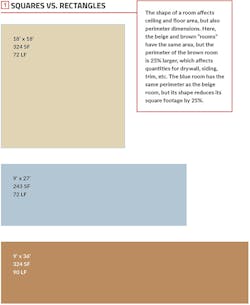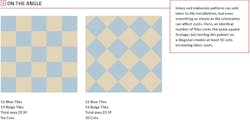That said, square-foot pricing can be deceptive because the shape of a space affects the cost to build or remodel it. Taken individually, one square foot may be identical to another, but take two identical square-foot areas and arrange them differently and you may end up with significant differences in the cost to remodel.
Square vs. Rectangle
Let’s take a look at a few examples, starting with simple shapes. Imagine you are pricing drywall for the beige and brown “rooms” in the illustration [1]. Both rooms have exactly the same square footage, so the quantity of drywall needed for the ceiling is also the same. But because the beige room is square, its perimeter dimension is smaller than the rectangular brown room. Assuming equal wall height in both rooms, the quantity of drywall needed for the brown room is 25% higher. If you use a drywall estimating formula that converts floor area to total ceiling and wall area based on a square shape, your total price for the rectangular room will be 16% too low, as shown in the table “Drywall Pricing Comparison” [2]. To get an accurate drywall price, you need to calculate the wall footage separately for these two rooms.
Now look at the blue room. It is smaller than the brown room in area and perimeter, but compared with the beige room, its perimeter dimensions result in 25% less ceiling area. In this case, if you convert floor area to total wall and ceiling area, your price will be 9% too high. Yes, that’s more profit for you if you get the job. And you might, if it’s just one room. But what if it’s five rooms?
The table shows the hypothetical dollar differences for all three rooms based on an installed drywall price of $2/SF (you can adjust the math to match your pricing). The dollar amounts for just one room are small, but the percentages are significant, particularly as you add the square footage of rooms together. Five rooms, five times the potential for error.
And drywall is just one example. If we were building two additions in the same proportions as the beige square and the brown rectangle, the brown room would be significantly more expensive because of its shape. The foundation would have more concrete wall area. More studs would be needed to frame the walls, and more sheathing and sided needed to close them in. Corner trim is the same, but there is more skirting and bed board, and more baseboard and crown molding. Exceptions include the floor framing, which would be less expensive because standard joists could easily span the 9 feet between walls, whereas the 18-foot span of the beige square would likely require I-joists or a support beam. The roof framing would also be cheaper because of the shorter span.
Cutting Corners
The same kinds of errors crop up in other parts of the estimate. Take crown and baseboard molding, for example. Using square footage of floor area makes no sense here because it’s the linear feet (LF) of wall that is important. But even then you also need to account for the number of corners.
The illustration [3] shows two rooms with exactly the same square footage of floor space and the same perimeter dimensions. But because of returns at two closets, the beige room has slightly less total baseboard but more baseboard corners. If you use straight linear footage to estimate installed baseboard, the cost of cutting the additional corners will outstrip any savings in trim material.
Pattern Recognition
Let’s look at one final example of places where square-foot pricing can cause problems. The two tiled areas in the illustration [4] are identical in size and shape,and material quantities are the same; only the direction of the tile has been changed. The rectilinear pattern generates less waste and has fewer cuts than the diagonal pattern. But, calculated by the square foot, the unit price for either would be the same.
Estimating software based on 3D digital renderings can theoretically eliminate most of these errors because it counts corners and linear footage as well as square footage. But it isn’t foolproof. The accuracy of estimating software is only as good as the data put into it. Make sure the software you’re using can handle differences created by shape, orientation, and other factors that mere counting can easily overlook.
And the next time someone asks you what your price-per-square-foot is, tell them it depends on a lot of things ... including the shape of the room.
About the Author
Sal Alfano
Executive Editor
Sal Alfano is executive editor for Professional Remodeler. [email protected], 202.365.9070





